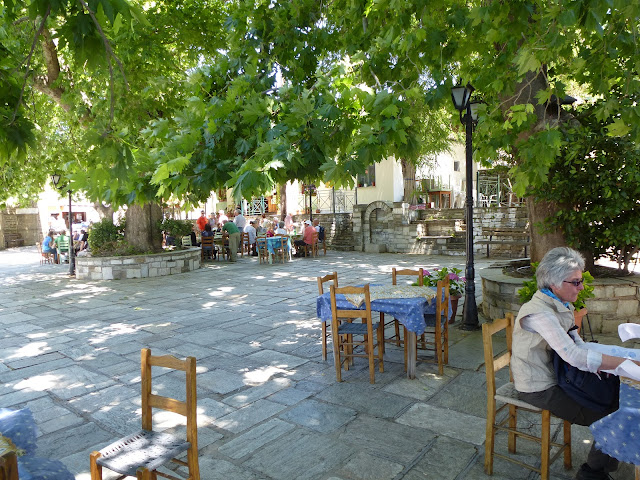Distance: 15,9 km
Time: 7 hours with stops
Altitude: from 240 m. (Veneto) to 534 m. (max) to 0 m. (Agios Nikolaos)
Total elevation gain/loss: 877 m.
Signed with metal signs, red paint, sky blue paint (see text)
Drinking water on walk: at Flamouri mon. (extra 1/2 hour with return)
Download GPS track (gpx):
from Wikiloc
This is a 7-hour circular walk in the wild nature of North Pelion, which gives us the chance to visit the mysterious Paliokastro (Old Castle) of Veneto and Flamouri monastery`s ruined dock at cape Agios Nikolaos. We can also visit the monastery, walking an extra half hour with return.

Starting from the square of Veneto, we climb the steps up to the cement paved road, on which we walk to the left (east). We go past the church of Agios Nikolaos and a drinking water fountain below on the left, and exit the village. At the road junction we go straight ahead towards ''ΠΕΤΡΟΜΕΛΙΣΣΟ'' (Petromelisso beach). In a short distance we come to the road-path junction, signed with plenty of signs, where we enter the path on the right towards Flamouri monastery. The path-kalderimi goes into woodland, alternating with rocky terrain.
 |
| Into the woodland |
Further on we come down to cross a large ravine, called Kakorema, which opens to the sea at Petromelisso beach.
 |
| Going down to cross Kakorema stream |
Climbing on the other bank, we reach a rocky plateau on the ridge, called ''Petrialo'', with a nice view to the Aegean sea. The path continues on a straight line and comes down to cross another stream. On the other bank we come shortly to a signed junction.
The path on the left descends gently towards the monastery`s ruined dock (Agios Nicolaos). We take the other path on the right, which climbs on the slope, becoming a kalderimi. At the ridge we come to a yellow signpost, indicating the left turn we will take, in a direction towards Koromblia peak, Alfons memorial and also Paliokastro. The Flamouri monastery is about fifteen minutes of walking time from here (on the path straight ahead), so if we want to visit it will take half an hour with return.
 |
| Flamouri monastery |
From the yellow signpost at the ridge, we turn left and descend on the rocky slope, cross the stream of Vathoulomeni. and climb on the other bank in an easterly direction.
We enter woodland for a little while and continue climbing on rocky ground, where vegetation is lower, always following red marks. At the point where the red waymarks begin to take a southerly direction to the right (attention!), we notice sky blue marks on our left and follow them, going gently downhill on a northeasterly direction. We pass by a small clearing called Loggarakia and continue descending into woodland.
 |
| Arbutus andrachne |
Exiting the woodland, the blue arrow to the left indicate the location of the Paliokastro of Veneto. This is a ruined fortification, with thick walls up to two metres high in a trapezoid shape. It remains unknown who, when and why would undertake such a building in this remote, unpopulated area, without water. There is absolutely no mention of it in written archives. Kostas Liapis, whose book about the many ''Paliokastra'' of Pelion (in Greek) contains valuable information about the subject, makes the assumption that it might be built around the 14th century A.D., to protect local shepherds from pirate attacks.
 |
| The north wall of Paliokastro |
Leaving the mysterious Paliokastro of Veneto to its quiet, we return back to the arrow and follow the other one to Spilies, descending on the slope into woodland in an easterly/southeasterly direction, finding the path again. Soon we meet a small stream and follow its course in a northeasterly direction, having the stream on our left.
 |
| Marking with sky blue paint |
Further down, the path becomes unclear for a small section, but we keep walking on the same direction following the sky blue waymarks. The path becomes obvious again, and finally opens to the wider O2 national path (Veneto-Pouri), some fifty meters above the sea level, on which we walk to the left (northwest). We can see the sea caves on the coastline. This area is called Spilies (Ipnoi in ancient times, when a considerable part of Xerxes` fleet sank in the rocky coast in a storm, during the Persian invasion in Greece).
 |
| The sea caves |
After a while, watching on our right, we come to a junction and follow the sky blue signs that mark the coastal path to Agios Nikolaos. On our way we pass next to the hollow roof of a sea cave (we can see the sea below). Reaching the small rocky beach, we can see the ruins of Agios Nikolaos chapel next to the derelict building of Flamouri monastery`s old dock (
tarsanas), At the far distance, if the sky is clear, we can make out Athos mountain.
 |
| Looking at Agios Nikolaos from the north |
Continuing on the path uphill, this joins again the O2 path, always marked with red paint, near an abandoned pen. Here the blue marks cease. We follow the main path to the right (north), cross two streams and then the path-kalderimi opens out to an earth road (which leads to Petromelisso beach). We walk on that road uphill to the left, finally reaching Veneto after about half an hour on the road.
 |
| Veneto |







































